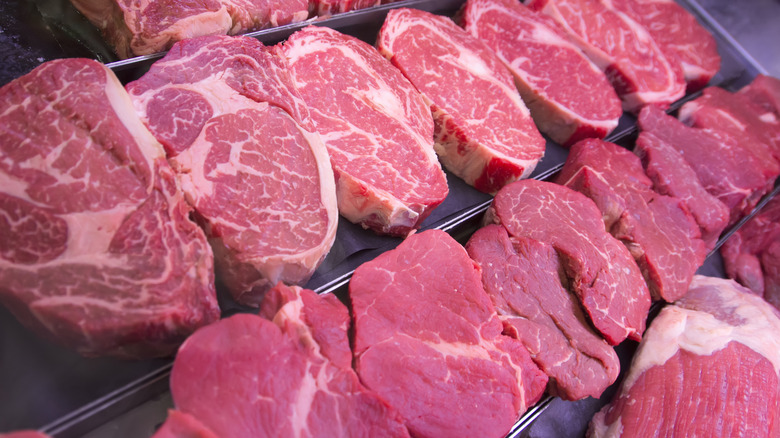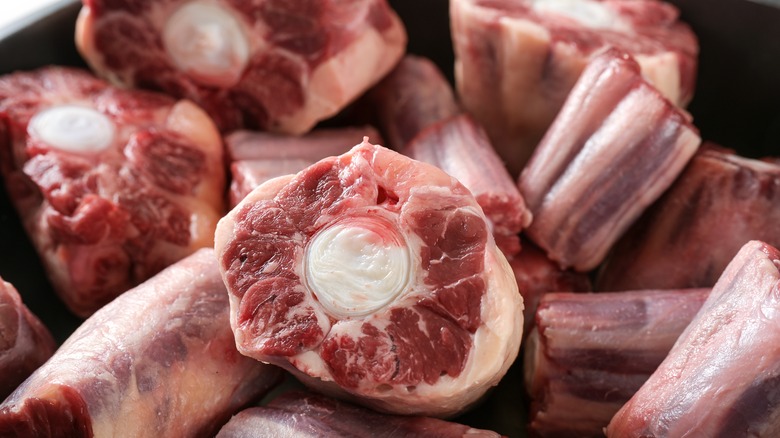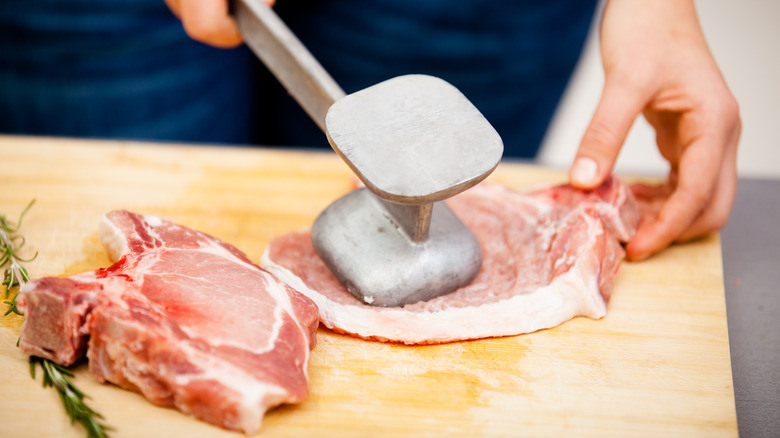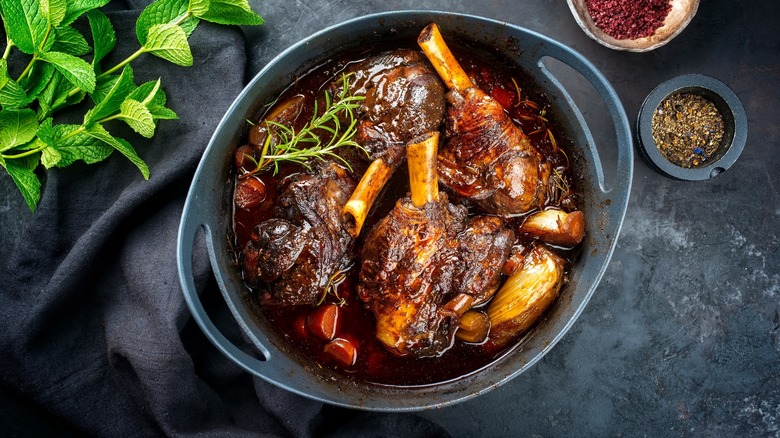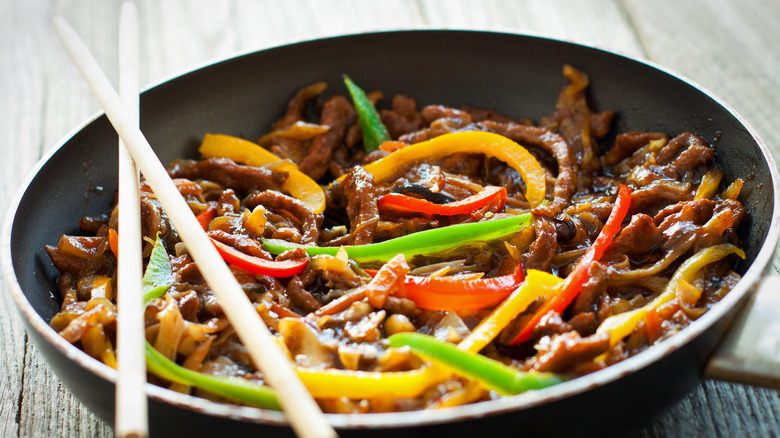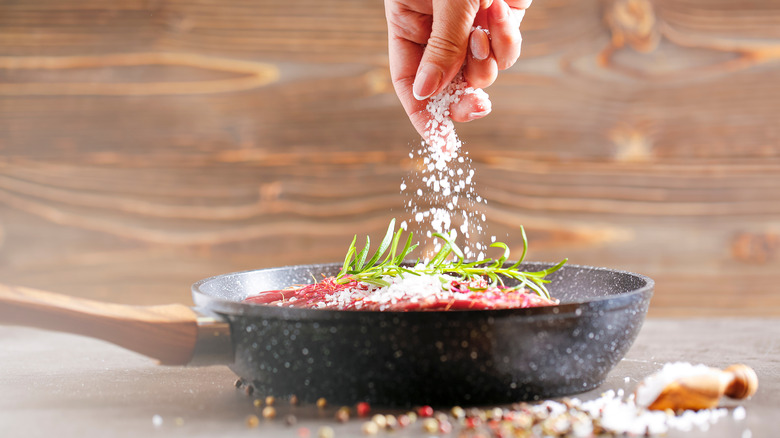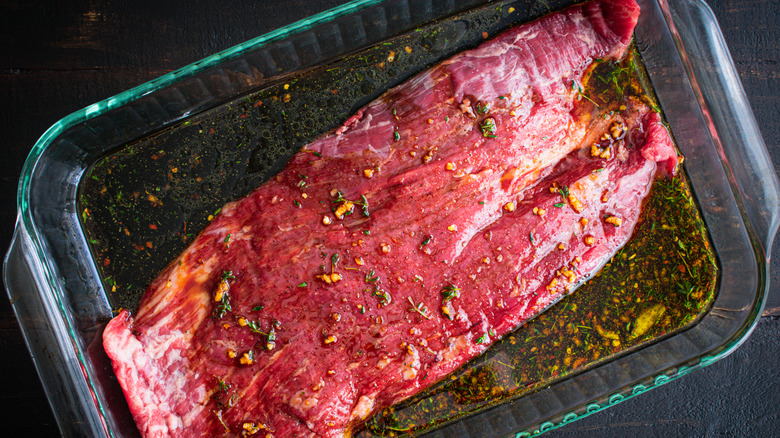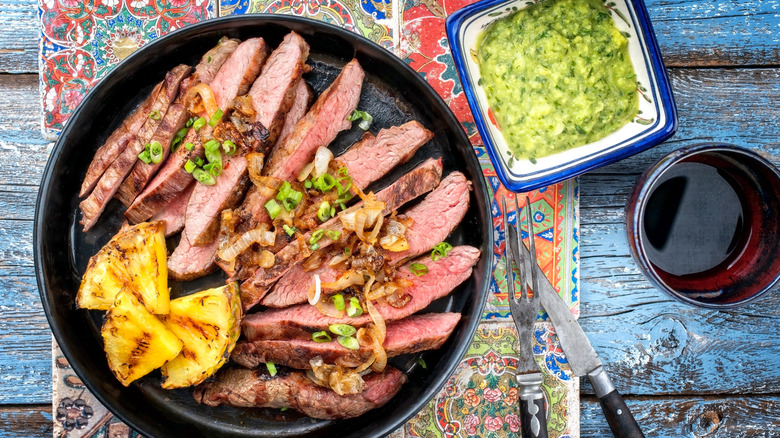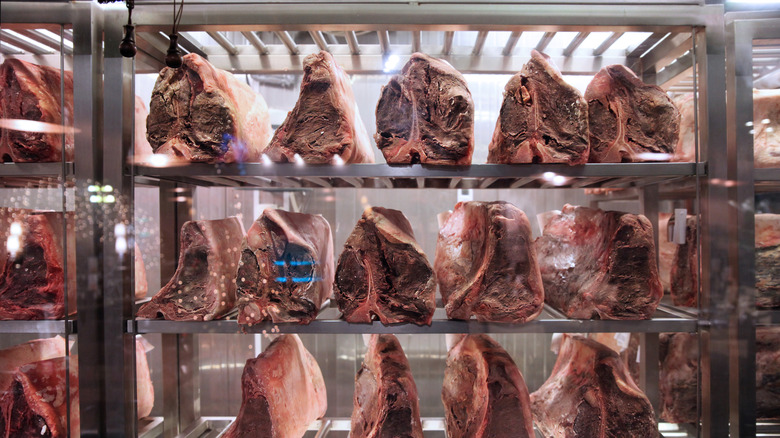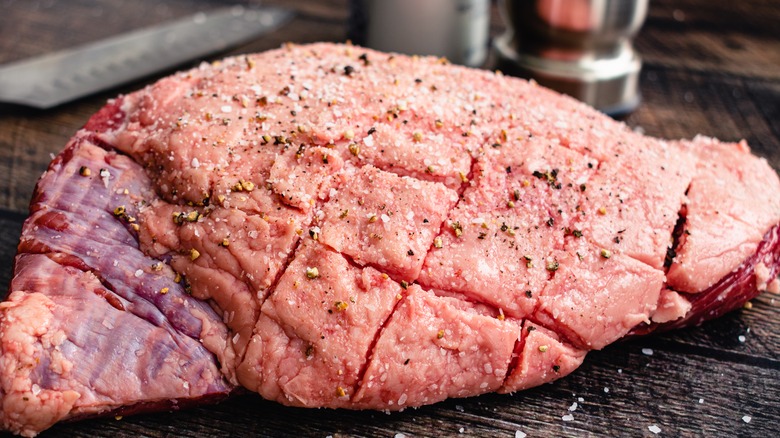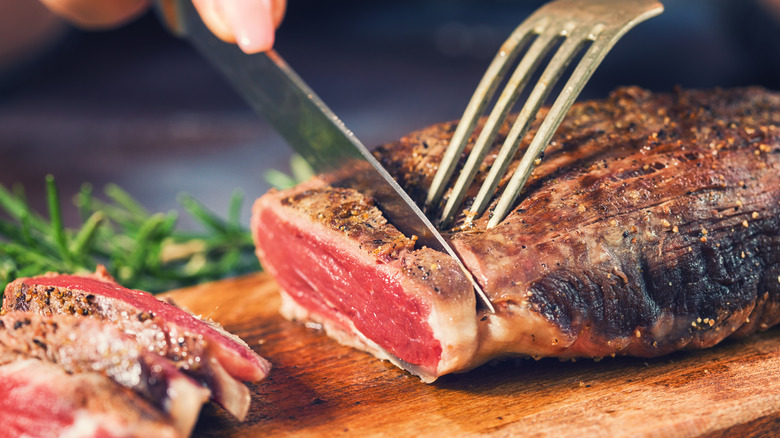Mistakes Everyone Makes When Tenderizing Meat
If you've ever cooked a steak to only find out that once you took a bite, you needed to chew it far longer than you might have liked, then it may be high time you looked into tenderizing. Tenderizing meat helps to break down some of the meat's connective tissue either before or after cooking, leading to a far more pleasant eating experience. And you may be surprised to learn that there are a whole lot of techniques that do the job.
Whether you're actively breaking down the meat's structure with a meat mallet or taking advantage of the transformative effects of acidic or alkalizing marinades, a host of options opens itself to the discerning home cook looking to improve the texture of a tough cut of meat. That said, there are also many ways you can misstep, from marinating for too long to using a meat mallet incorrectly, or assuming you need to buy unitasking tools at all. We've tapped culinary experts from across the country to glean their tips on tenderizing meat. They've offered their time-tested expertise, shining a light on all of the mistakes you're likely making when attempting to do this process at home.
Not picking the right cut
If you ask Jimmy Chill, Head Chef & Culinary Director at Branja Miami, if your meat requires tenderizing, it's a pretty bad sign. "If your meat needs to be tenderized; sorry to break it to you, but you're buying terrible quality meat," he says. But this advice comes with a caveat. While a beef tenderloin that isn't tender definitely means your meat is not of the highest of calibers, some cuts do indeed require tenderizing just by which part of the animal they come from.
Generally speaking, the more connective tissue a muscle has, the more the resulting cut benefits from tenderizing. The more a muscle works during the animal's life, the more connective tissue it has. It's for this reason that Katie Flannery, one half of the father-daughter team behind online meat purveyor Flannery Beef, explains that cuts from the legs and sides of the animal are those that need tenderizing the most. These include cuts like bottom round, top round, short ribs, bavette, brisket, or chuck. "I don't think any of these cuts are harmed by tenderizing," she says. "Ones that would be harmed don't need tenderizing in the first place." Members of the latter category include the aforementioned beef tenderloin or ribeye. Tenderizing these already-tender cuts, according to Chef Kenny Gilbert, VP of Culinary Operations, Grove Bay Hospitality Group, is "not necessary."
Not using a meat mallet properly
Perhaps one of the most common methods for tenderizing meat is using a meat mallet. This tool looks like a hammer with one flat side and one more textured side. The flat side is typically used to pound thick or uneven pieces of meat thinner without necessarily tenderizing them. It's the "spiky tooth side," Katie Flannery explains, that does the tenderizing work, "physically breaking down dense tissue and fibers of the meat," she explains. "It basically masticates the surface."
But you don't want to go hammering your meat all willy-nilly. For Kenny Gilbert, the best way to use a meat mallet is to first place the meat between two pieces of plastic wrap. Set the meat on a cutting board, then use the mallet and pound it until tender. Take care not to be overzealous, Flannery counsels; over-tenderizing can result in too thin a piece of meat, which makes it almost impossible not to overcook it. "Make smaller hits and take your time," echoes Matt Kreider, Executive Chef at Steak 954. "Trying to do too much at once will result in a poor product." If you don't have a mallet, there's no need to go out and buy one: Other kitchen workhorses that do the job include the flat, heavy side of a butcher's cleaver, a heavy skillet with a flat bottom, or a rolling pin.
Forgetting about slow-cooking
Perhaps one of the most common ways of rendering typically tougher cuts of meat fall-apart tender is to cook them low and slow: Braised sirloin tips, smoked corned beef, or slow-cooked beef bourguignon are all examples of how this technique can render delicious results.
"Slow cooking is magic," says Katie Flannery, who explains that when meat is cooked at around 160 F for a long period of time, it encourages the tough collagen to melt into silky smooth gelatin. This method often takes hours, leading some home cooks to assume if they just turn up the heat they'll be able to speed things up. Unfortunately, this is the opposite of what you should do. Increasing the temperature actually makes the muscle fibers tougher.
"That's the reason why certain cuts perform beautifully when slow cooked, but poorly when cooked in high heat / fast methods," explains Flannery. That said, you can speed things up considerably by relying on the high-pressure of a pressure cooker or slow cooker, which may reduce the cooking time from three hours to just one and result in an equally tender finished product.
Not taking a page from Chinese cuisine
Chinese stir fries frequently rely on a technique known as velveting to tenderize the meat and lend it a lovely, silky texture. This technique relies on marinating the meat in alkaline ingredients, which raises the pH levels on the surface of the meat. As a result, it becomes more difficult for the protein molecules in the meat to bond when heat is applied, and the meat doesn't constrict quite so much when cooking, thus remaining more tender. "Velveting is a fun cooking process using a cornstarch slurry as a marinade, and a good way to break down a product," explains Matt Kreider. "Some cooks use baking soda which will really help break the proteins down and make a really tough cut really enjoyable."
Egg whites are another frequently-used element in velveting, which Tim Ma, chef and founder of Lucky Danger, tells Food Network is "the foundation of Chinese cooking." He explains that, "It doesn't only tenderize tough, chewy parts of proteins, but it also creates a surface area to absorb thick sauces." This is why, for Katie Flannery, this technique can also be used in other saucy dishes relying on thin cuts of meat, such as beef stroganoff. Kreider notes, however, that if you're using baking soda in your marinade, you may want to rinse before cooking. "The taste of baking soda can be off-putting," he says.
Neglecting the power of salt
Salt isn't just a great way of adding flavor to meat; it's also a key ingredient for improving its texture, according to Matt Kreider. "Salt really does a good job to help break down the proteins and help with a tender product," he says. Salt works as a tenderizer in a number of ways. When applied to the surface of the steak, it draws out the steak's moisture, essentially creating a brine. Once it's reabsorbed into the meat, it dissolves muscle proteins like actin and myosin, rendering the meat itself tender and juicy. You can also take a page out of Kreider's book and begin with a wet brine, which will have a similar effect.
Either way, according to Katie Flannery, it's a crucial step on the path to the best-tasting steak. "It's undeniable that if you can swing it, salting and letting rest for a few hours, or even overnight in the fridge, will give you a tenfold return on that time investment," she says.
Forgetting about acidic marinades
Marinades are yet another way of improving both the texture and the flavor of your meat. While we've already seen that marinades containing an alkaline ingredient like baking soda can have tenderizing properties, marinades on the other side of the pH scale have a similar effect. Acidity serves to denature the proteins in the meat, rendering the cut more tender when cooked (via Utah State University Extension). "An effective marinade," according to Katie Flannery, "contains acidic ingredients, like lemon juice, buttermilk, low-pH fruits, wine, Coca-Cola, and vinegar, that break down sinew and fiber."
That said, one must be wary of applying acidic marinades too far in advance. "Of course, you can go overboard," says Matt Kreider, noting that if you over-marinate your meat in an acidic solution, you run the risk of turning it into mush or jerky. "You don't want to compromise the integrity of the product," he cautions. Flannery echoes this warning. "Don't make the mistake of thinking 'longer = more tender,'" she explains. She suggests marinating a thin cut like a skirt or flank steak no longer than a few hours; a thick cut like top sirloin, she says, can be marinated up to — but no more than — overnight.
Not taking advantage of the transformative power of natural enzymes
Acidity and alkalinity are just two of the characteristics of marinades that can help tenderize meat. Cooks around the world also take advantage of enzymes like the bromelain in pineapple, proteases in Korean pears, papain from papaya, or actinidin in kiwi for flavor and texture: Think tacos al pastor or Korean bulgogi marinated in pear. Each of these enzymes essentially breaks down the protein in muscle fibers, contributing to their tenderness.
And fruits are not the only ingredients with these powers. Indeed, the same holds for the phosphates and lactic acid in dairy like milk, yogurt, buttermilk, or kefir, or the combo of phospholipids and phosphates in mayonnaise. It's no wonder a yogurt marinade results in such a tender chicken gyro. That said, as with acidic marinades, you'll want to be careful of over-applying these powerful ingredients, according to Kenny Gilbert. "When you add plant based enzymes like pineapple, papaya, kiwi, they can help tenderize," he says, cautioning nevertheless that, "if you use too much, the meats will breakdown to mush."
Forgetting about fermentation
Some cooking traditions take advantage of the power of fermentation to tenderize meat, according to Matt Kreider, such as the koji cure preferred by many a Japanese establishment. This fermented soybean paste adds loads of flavor and texture to both meat and fish.
At Steak 954, Matt Kreider opts instead for a technique that may be more familiar to Western diners: Dry aging, which is essentially controlled rotting. "Controlled temperatures and humidity to break down protein and add awesome flavors," he explains of this technique, which encourages enzymes and bacteria to break down the muscle fibers in the meat. And while it's tough to recreate the environment of the perfect dry-aging fridge at home, there are indeed ways you can capitalize on this time-tested know-how if you've got a sous vide machine. "Make sure the meat is dry of any liquids, place the meat in a vacuum safe bag, and use the sealer to seal it," suggests Jimmy Chill. "Let it rest in the fridge for at least a week and this will make any cut a bit more tender and release some new flavors."
Not scoring your meat before cooking it
You've already seen it with a whole baked ham, but scoring is just as worthwhile a technique for smaller cuts requiring tenderizing. All you need to do is use the tip of a sharp knife to cut shallow cuts across the grain of the meat, forming a perpendicular quadrillage on its surface. This method makes it easier to season deep into the meat, creating the perfect crispy edges and tender interior. On fatty cuts like picanha, scoring can also help with a more even distribution of fat and a crispier final texture.
Katie Flannery notes, however, that scoring is not the only way to take advantage of the tenderizing properties of a sharp knife. "From a tenderization point of view, technically yes scoring would help a bit," she says. "But what's even better is to slice thin and against the grain. If I do that, I don't need to score."
Not slicing across the grain
Your steak has dry-aged and marinated, it's been perfectly seasoned and cooked just enough. You're ready to serve ... right? Not quite. There's one more tool at your disposal that, according to our experts, may be even more essential than any of these pre-cooking steps. "I think the most important thing to remember is to slice across (perpendicular to) the grain of the meat," says Katie Flannery. "This is the greatest equalizer in terms of tenderness."
The grain of the meat is the direction in which the fibers run. In many cuts, this will be easy to see, but be aware that some steaks, such as tri-tip, actually have two grains and thus require you to switch directions partway through slicing. Slicing against the grain is essential for tough cuts, but it's just as important for steaks that are generally tenderer. "Remember to always slice against the grain structure of the product," says Matt Kreider. "Even tender cuts can be tough if cut improperly."
